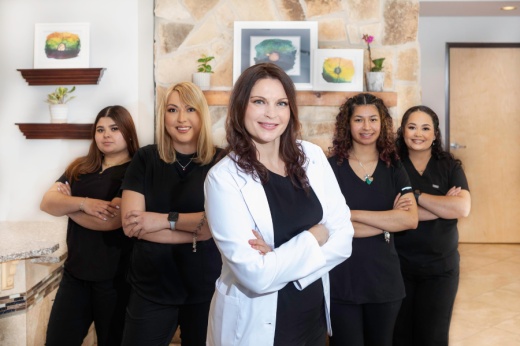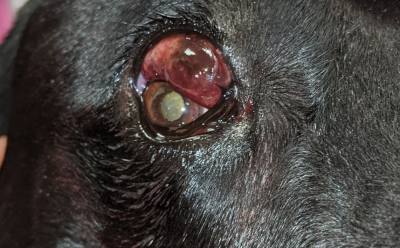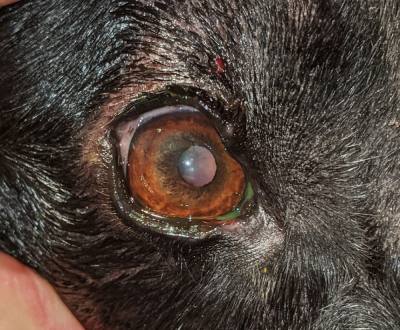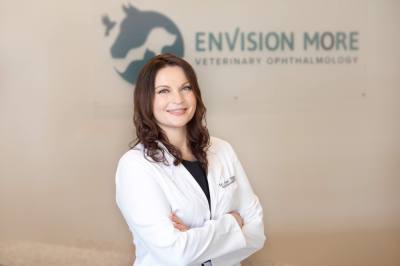A pet’s quality of life is greatly impacted by the health of their eyes. In this Q&A, Dr. Angela Griggs, veterinary ophthalmologist and owner of Envision More Veterinary Ophthalmology, discusses diagnosis, treatment and common misperceptions about pet eye care.
When a dog has been diagnosed with diabetes, why is it important for their owners to be aware of potential eye problems?
Griggs: 75% of diabetic dogs will develop cataracts within a year of developing diabetes. If they start seeing eye problems, don’t ignore it. Usually it starts with redness, squinting, or discharge.
That first diagnosis of diabetes, it’s a lot to take in for [dog owners]. ‘How do we give insulin?’ You have to roll it, keep it in the fridge. ‘This is how you pull up a syringe. You can’t give them treats any more. And you need to keep them on a 12-hour diet.’ That is so much for the average pet owner to take in.
When I’m talking to general practitioners, I usually tell them, somewhere in your diabetic instruction to owners, mention that the dog is probably going to get eye problems. This is just another thing that diabetes brings. And we will keep a look-out for that.
Within the first three months or so, once the pet is regulated on their insulin and they’re into the daily routine of giving shots, bring them in for an eye exam.
How do the cataracts develop?
Griggs: Even if the blood sugar is controlled by the insulin, there are dips and spikes throughout the day. When they’re in that spiked area, that’s when the cataracts come on in as little as three days. The dog can be normal on Sunday and completely blind on Wednesday.
Besides diabetes, are there other reasons dogs develop cataracts?
Griggs: The other common reason is genetics, which can happen at any age. Other factors could be trauma and inflammation inside the eye, which can lead to cataracts.
Is it true diabetes can bring on other types of eye problems that need care?
Griggs: Yes, other ocular manifestations of canine diabetes mellitus can be retinal disease, decreased corneal sensation, and abnormal tear production or quality.
Are there different types of surgery options for a dog who has cataracts or one of the other problems?
Griggs: Cataract surgery is the only treatment for cataracts.And is around 90% successful. We wait until a stage where they’re visibly bumping into things and it’s difficult for them to visually track things anymore before we recommend surgery. And I can tell the owners, your dog won’t see without the surgery, but with surgery, there’s a 90% chance they will.
You also offer basic eye exams at your clinic for pet owners who just want to check on their pets’ eye health?
Griggs: Yes, we check for corneal ulcers, or abrasions on the eye. The most common reason we see corneal ulcers is they have dry eye. And they got one of those spontaneous dry spots that ulcerated and now it’s painful. They won’t open their eye, it is often infected, and left untreated it can actually rupture the eye.
Your clinic is offering complimentary eye examination for recently diagnosed diabetic dogs in April and May, is that correct?
Griggs: Yes, and if your well-being depends on a special service animal or if you are responsible for a working animal – military, search and rescue, police force – you can register them for a complimentary eye exam during the month of May. These annual screening exams are designed to detect eye disease that may affect vision. You can find more information at www.acvoeyeexam.org.
Dr. Angela Griggs is a Diplomate of the ACVO. You can read more about the American College of Veterinary Ophthalmologists at acvo.org. There are less than 500 actively practicing board certified veterinary ophthalmologists in North America.
Becoming a veterinary ophthalmologist requires completing veterinary school, then an internship, followed by a residency in comparative ophthalmology which is a 3-4 year experience, depending on the program.
Want to read more about Dr. Griggs, learn more about Envision More Veterinary Ophthalmology, or contact them? Find out more by visiting envisioneyevet.com.
The above story was produced by Community Impact's Storytelling Multi-Platform Journalist Victoria Schaefer with information solely provided by the local business as part of their "sponsored content" purchase through our advertising team. Our integrity promise to our readers is to clearly identify all CI Storytelling posts so they are separate from the content decided upon, researched and written by our journalism department.
Select your community
Support Us
News
- Austin Metro
-
Houston Metro
- Houston Metro Home
- Bay Area
- Bellaire | Meyerland | West University
- Conroe | Montgomery
- Cy-Fair | Jersey Village
- Cypress
- Heights | River Oaks | Montrose
- Katy | Fulshear
- Lake Houston | Humble | Kingwood
- New Caney | Porter
- Pearland | Friendswood | Manvel
- Spring | Klein
- Sugar Land | Missouri City
- The Woodlands
- Tomball | Magnolia
- Dallas | Fort Worth Metro
- San Antonio Metro










